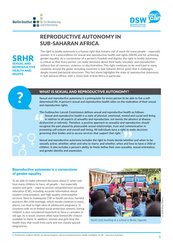
In this fact sheet, the DSW and the Berlin Institute take a look at the situation of reproductive rights in Sub-Saharan Africa.
Read more
West Africa has one of the fastest growing populations in the world. It is projected to nearly double by 2050, when close to 800 million people are projected to live in the region. As a result, more people than ever will need education opportunities, jobs and health care services – all of which are necessary for people to lead a self-determined life with dignity, and which are already in short supply today. While fertility rates in West Africa are already declining, ongoing interventions are necessary to ensure this trajectory continues.
New opportunities for successful interventions that increase the acceptability and uptake of family planning can be found in partnerships with an unexpected group of stakeholders: faith-based organisations. In West Africa, religious actors and leaders enjoy a high level of trust. When it comes to sensitive topics such as family size or sexuality, three quarters of West Africans heed the counsel of their priest or imam. Though religious leaders in the region have traditionally been seen as opponents of family planning, a closer look reveals a more nuanced picture.
In the study commissioned by the Konrad Adenauer Foundation, “Faith in action – How religious organizations advance demographic change,” the Berlin Institute explored how religious authorities and organisations in sixteen West African countries are engaging on critical sociodemographic issues – such as gender equality, family planning and sexuality – and advocating for improvements and greater self-determination in these areas.
Executive Director
Telefon: +49 30 - 22 32 48 45
Contact via Mail: hinz@berlin-institut.org
© Berlin-Institut
Project Coordinator International Demography
Telefon: +49 - 30 31 01 95 91
Contact via Mail: rose@berlin-institut.org
© Berlin-Institut
Demographic change is not a disaster, but a challenge. Analyses and concepts are needed to master them successfully. The Berlin Institute for Population and Development provides these free of charge and makes a significant contribution to ensuring that important future issues are discussed on a broad basis and put on the political agenda. The non-profit Berlin Institute works on a non-partisan basis and receives no state funding whatsoever. Your donation therefore helps to maintain our independence and the high standard of our publications. Donations to the Berlin Institute are tax-deductible and can be made directly online using the donation button or by using a bank transfer form to the following account
Donation account
GLS Bank
IBAN DE15 4306 0967 1276 4833 00
BIC/SWIFT GENODEM1GLS
We thank you very much for your support!